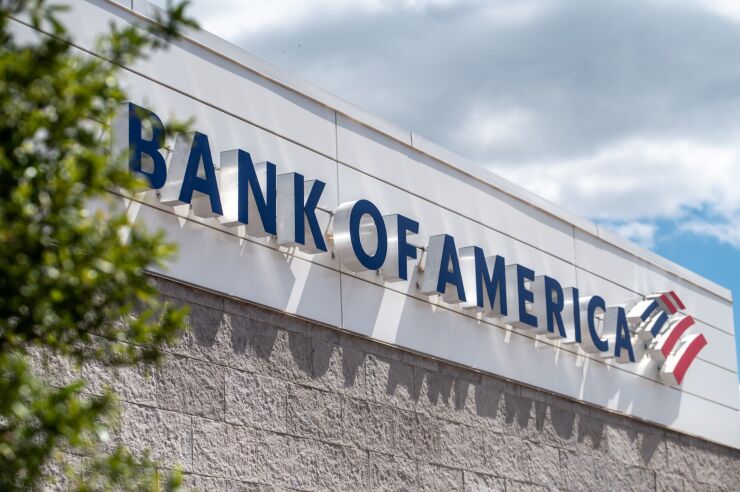
Bank of America, which has a relatively large percentage of its deposits in transaction accounts, has weathered the sharp interest rate hikes of the last year better than many banks. Now the question is when it will be able to play offense.
The Charlotte, North Carolina, company reported Tuesday that the average rate on its interest-bearing deposits during the second quarter was 1.82%. That was less than JPMorgan Chase, which paid 2.24%, and only slightly higher than Wells Fargo, which paid 1.63%.
And of course, the largest U.S. banks have generally been able to pass along a thinner percentage of the Federal Reserve's rate hikes to customers than their smaller counterparts have.
"Transactional accounts are typically pretty sticky and not terribly rate-sensitive," said David Fanger, senior vice president of the financial institutions group at Moody's Investors Service. "BofA isn't giving away the store."
Still, the Fed's 16-month-old inflation-fighting campaign has had large effects on Bank of America's balance sheet.
During the second quarter, average deposit balances of $1.9 trillion were down 7% from the second quarter of 2022, and off by 1% from the first quarter of this year.
The average rate that BofA paid on interest-bearing deposits during the quarter — 1.82% — was up sharply from just 0.11% a year earlier. It sat at 1.38% during the first quarter.
Interest-bearing deposits grew 1% from the first quarter and 6% from the year-earlier period. Meanwhile, non-interest-bearing deposits declined by 7% from the first quarter and by 23% from the same period last year.
"We're just reacting to what we see from our customer base," BofA Chief Financial Officer Alastair Borthwick said Tuesday during the bank's quarterly earnings call.
As the Fed has hiked rates, many banks have reported deposits shifting from non-interest-bearing to interest-bearing accounts. They have also been paying higher rates on interest-bearing accounts in an effort to hold on to their deposit funding.
At BofA, some seasonal factors served as headwinds during the second quarter. In its consumer and wealth management business, BofA cited the spring tax season as one of the factors that led to fewer deposits.
Consumer deposits of $1 trillion were down 7% from the same period last year, with BofA pointing to higher customer spending and debt payments, as well as some customers moving their balances into brokerage accounts.
The $3.1 trillion-asset bank said its wealth management group saw deposit declines earlier in the second quarter as clients continued to move funds into higher-yielding accounts, but that the trend stabilized by the end of the period. Overall, deposits in wealth management fell by 19% from the same period a year earlier to $295.4 billion.
In the global banking business, deposits fell by 2.3% from a year earlier to $497.5 billion. BofA's global banking deposits are mostly transactional deposits used by commercial clients to manage cash flows, according to the bank.
The deposit pressures contributed to a 2% quarter-over-quarter decline in net interest income, which totaled $14.2 billion during the second quarter. Still, net interest income was up 14% from the second quarter of 2022.
The bank's net interest yield of 2.06% was down from 2.20% in the first quarter, but up from 1.86% in last year's second quarter.
Borthwick said that a tightening balance sheet is to be expected as the U.S. economy contracts in response to the Fed's efforts to combat inflation.
But he noted that the economic outlook for the rest of the year has stabilized, and he said that BofA now has "slightly better" expectations for net interest income growth. Still, BofA is continuing to project that net interest income in 2023 will increase by around 8% from last year.
"What will largely drive things from here is just normalization of deposits and good old-fashioned loan growth," Borthwick said. "The Fed's engineering this across the board."






